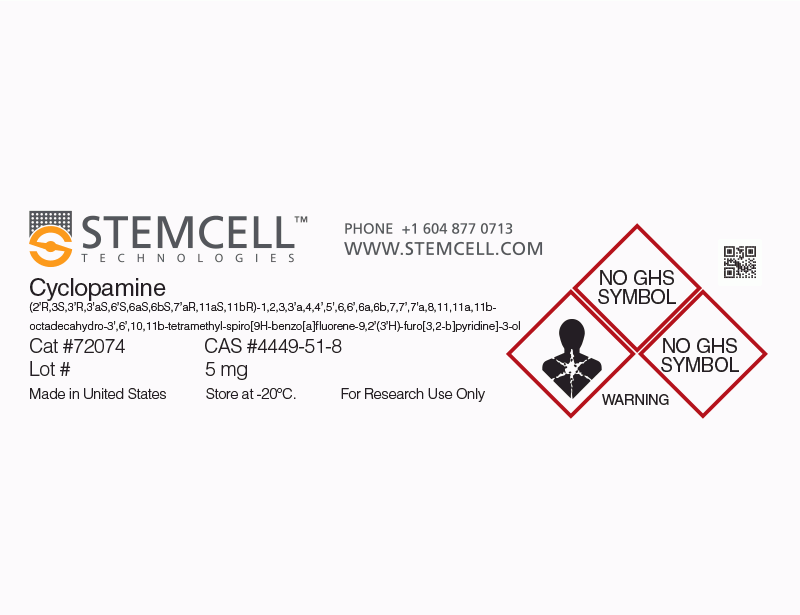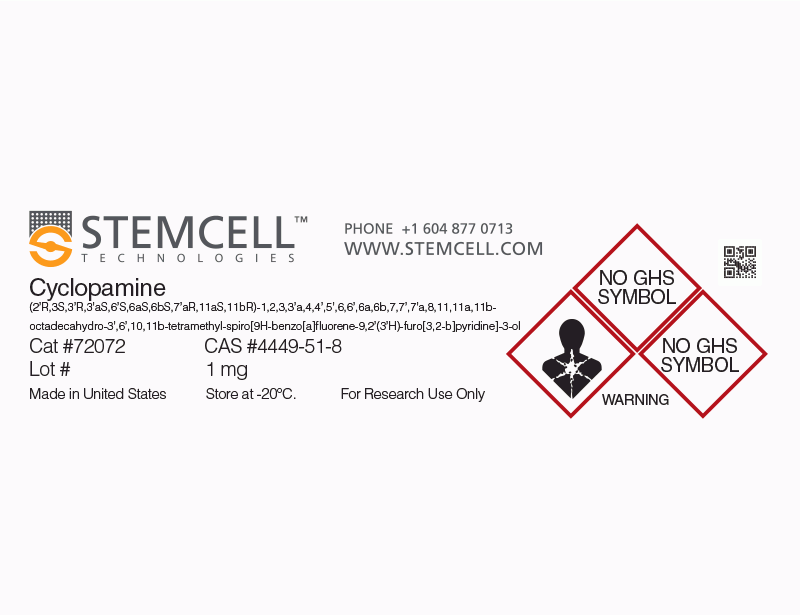Cyclopamine
Hedgehog pathway inhibitor; Inhibits Smoothened (SMO)
概要
Cyclopamine is a steroid alkaloid that inhibits the Hedgehog pathway at the point of the pathway activator Smoothened. Cyclopamine binds to the heptahelical bundle of Smoothened, a G protein-coupled receptor, and prevents it from signaling further downstream (Chen et al.).
MAINTENANCE
· Reduces proliferation of rat neural progenitor cells and mouse neurospheres (Lai et al.; Palma and Ruiz i Altaba).
· Reduces proliferation of mouse mammospheres (Liu et al.).
DIFFERENTIATION
· Promotes differentiation of pancreatic cells from human embryonic stem cells (D'Amour et al.).
CANCER RESEARCH
· Inhibits the growth of human and mouse medulloblastoma cells, and human glioblastoma cells (Bar et al., Berman et al.).
MAINTENANCE
· Reduces proliferation of rat neural progenitor cells and mouse neurospheres (Lai et al.; Palma and Ruiz i Altaba).
· Reduces proliferation of mouse mammospheres (Liu et al.).
DIFFERENTIATION
· Promotes differentiation of pancreatic cells from human embryonic stem cells (D'Amour et al.).
CANCER RESEARCH
· Inhibits the growth of human and mouse medulloblastoma cells, and human glioblastoma cells (Bar et al., Berman et al.).
Alternative Names
11-Deoxojervine; Jervine
Cell Type
Cancer Cells and Cell Lines, Endoderm, PSC-Derived, Mammary Cells, Neural Stem and Progenitor Cells, Pancreatic Cells, Pluripotent Stem Cells
Species
Human, Mouse, Rat, Non-Human Primate, Other
Application
Differentiation
Area of Interest
Cancer Research, Neuroscience, Stem Cell Biology
CAS Number
4449-51-8
Chemical Formula
C₂₇H₄₁NO₂
Molecular Weight
411.6 g/mol
Purity
≥ 95%
Pathway
Hedgehog
Target
SMO
技术资料
| Document Type | 产品名称 | Catalog # | Lot # | 语言 |
|---|---|---|---|---|
| Product Information Sheet | Cyclopamine | 72072, 72074 | All | English |
| Safety Data Sheet | Cyclopamine | 72072, 72074 | All | English |
数据及文献
Publications (3)
Cancer research 2016 JAN
A Novel IL6 Antibody Sensitizes Multiple Tumor Types to Chemotherapy Including Trastuzumab-Resistant Tumors.
Abstract
Abstract
Elevated levels of the proinflammatory cytokine IL6 are associated with poor survival outcomes in many cancers. Antibodies targeting IL6 and its receptor have been developed for chronic inflammatory disease, but they have not yet been shown to clearly benefit cancer patients, possibly due to antibody potency or the settings in which they have been tested. In this study, we describe the development of a novel high-affinity anti-IL6 antibody, MEDI5117, which features an extended half-life and potent inhibitory effects on IL6 biologic activity. MEDI5117 inhibited IL6-mediated activation of STAT3, suppressing the growth of several tumor types driven by IL6 autocrine signaling. In the same models, MEDI5117 displayed superior preclinical activity relative to a previously developed anti-IL6 antibody. Consistent with roles for IL6 in promoting tumor angiogenesis, we found that MEDI5117 inhibited the growth of endothelial cells, which can produce IL6 and support tumorigenesis. Notably, in tumor xenograft assays in mice, we documented the ability of MEDI5117 to enhance the antitumor activities of chemotherapy or gefitinib in combination treatment regimens. MEDI5117 also displayed robust activity on its own against trastuzumab-resistant HER2(+) tumor cells by targeting the CD44(+)CD24(-) cancer stem cell population. Collectively, our findings extend the evidence of important pleiotropic roles of IL6 in tumorigenesis and drug resistance, and offer a preclinical proof of concept for the use of IL6 antibodies in combination regimens to heighten therapeutic responses and overcome drug resistance.
Stem cells (Dayton, Ohio) 2007 OCT
Cyclopamine-mediated hedgehog pathway inhibition depletes stem-like cancer cells in glioblastoma.
Abstract
Abstract
Brain tumors can arise following deregulation of signaling pathways normally activated during brain development and may derive from neural stem cells. Given the requirement for Hedgehog in non-neoplastic stem cells, we investigated whether Hedgehog blockade could target the stem-like population in glioblastoma multiforme (GBM). We found that Gli1, a key Hedgehog pathway target, was highly expressed in 5 of 19 primary GBM and in 4 of 7 GBM cell lines. Shh ligand was expressed in some primary tumors, and in GBM-derived neurospheres, suggesting a potential mechanism for pathway activation. Hedgehog pathway blockade by cyclopamine caused a 40%-60% reduction in growth of adherent glioma lines highly expressing Gli1 but not in those lacking evidence of pathway activity. When GBM-derived neurospheres were treated with cyclopamine and then dissociated and seeded in media lacking the inhibitor, no new neurospheres formed, suggesting that the clonogenic cancer stem cells had been depleted. Consistent with this hypothesis, the stem-like fraction in gliomas marked by both aldehyde dehydrogenase activity and Hoechst dye excretion (side population) was significantly reduced or eliminated by cyclopamine. In contrast, we found that radiation treatment of our GBM neurospheres increased the percentage of these stem-like cells, suggesting that this standard therapy preferentially targets better-differentiated neoplastic cells. Most importantly, viable GBM cells injected intracranially following Hedgehog blockade were no longer able to form tumors in athymic mice, indicating that a cancer stem cell population critical for ongoing growth had been removed. Disclosure of potential conflicts of interest is found at the end of this article.
Nature biotechnology 2006 NOV
Production of pancreatic hormone-expressing endocrine cells from human embryonic stem cells.
Abstract
Abstract
Of paramount importance for the development of cell therapies to treat diabetes is the production of sufficient numbers of pancreatic endocrine cells that function similarly to primary islets. We have developed a differentiation process that converts human embryonic stem (hES) cells to endocrine cells capable of synthesizing the pancreatic hormones insulin, glucagon, somatostatin, pancreatic polypeptide and ghrelin. This process mimics in vivo pancreatic organogenesis by directing cells through stages resembling definitive endoderm, gut-tube endoderm, pancreatic endoderm and endocrine precursor--en route to cells that express endocrine hormones. The hES cell-derived insulin-expressing cells have an insulin content approaching that of adult islets. Similar to fetal beta-cells, they release C-peptide in response to multiple secretory stimuli, but only minimally to glucose. Production of these hES cell-derived endocrine cells may represent a critical step in the development of a renewable source of cells for diabetes cell therapy.




